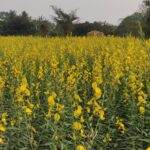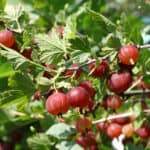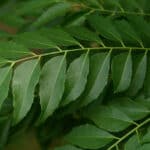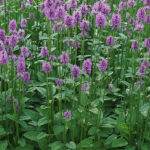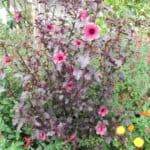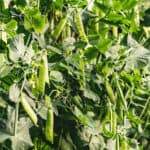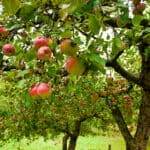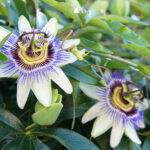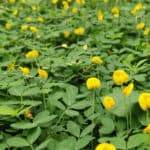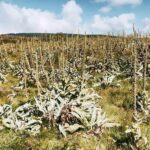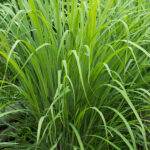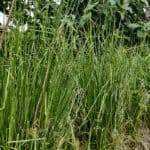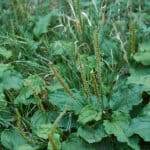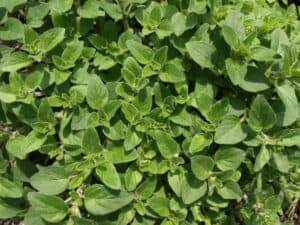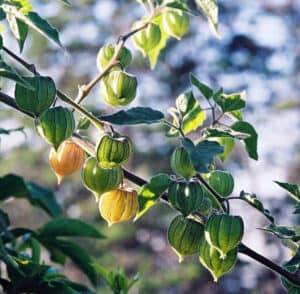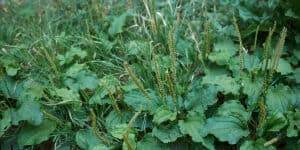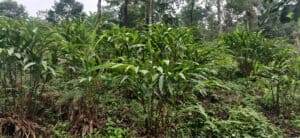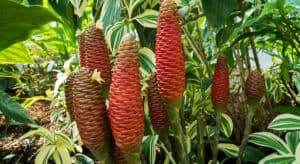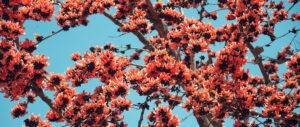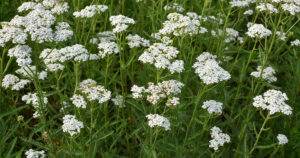Many of us are familiar with white sage as a smudging herb that purifies the air and disperses negative energy.
White sage is also highly medicinal – just as it helps to cleanse and disperse negative energy in the air, it helps to clear our respiratory system of unwanted pathogens and thick, stuck mucous.
However, considering the ethical and ecological concerns with white sage, it’s important now more than ever to learn how to grow and care for it ourselves.
In this in-depth growing guide, you’ll learn how to do just that – along with a brief dive into its history and how to harvest and utilize it in your home apothecary.
White Sage Overview
White sage (Salvia apiana) is a woody perennial shrub native to the southwestern United States, specifically southern California and northern Mexico.
As a member of the mint family (Lamiaceae), it bears highly aromatic leaves and characteristic two-lipped flowers.
White sage is also one of the common names for Artemisia ludoviciana, a native perennial shrub in the Asteraceae family that is present across most of the United States.
It is more well-known as white sagebrush or prairie sage and is especially important for Indigenous Plains tribes.
While both plants are highly aromatic and are similarly used medicinally and ceremonially, they are two distinct plants that are genetically unrelated.
White sage (Salvia apiana) is a sacred plant to Indigenous peoples of the Southwest United States and northern Mexico.
It is now an at-risk plant due to overharvesting in its limited native range.
Considering this, it’s essential for those who wish to use white sage, whether as a medicinal herb or smoke wand, to grow it themselves or only purchase cultivated white sage from reputable sources.
In the next section, we’ll dive into why this is important and how consumerism has abused white sage.
History of White Sage
White sage was (and is) used as a food, spice, ceremonial, and medicinal plant for thousands of years by the Indigenous tribes of its native range.
These tribes include the Cahuilla, Chumash, Kumeyaay, Alliklik (Tataviam), Kitanem, Mahuna, and other tribal nations.
While there were slight differences in how each tribe used white sage, it was common practice to use it as a “smudging” herb during ceremonies.
In this practice, white sage is rolled into a bundle and burned so that its smoke would clear the air of negative energy.
The smoke was also used as a blessing and a vessel for the people’s prayer to reach the Creator.
Throughout the tumultuous and shocking history of California tribes and colonial settlement, Native Americans from other locations moved to southern California and learned from local indigenous people white sage’s uses.
Because of this, white sage was adopted in other native ceremonial practices.
However, it wasn’t until the New Age movement during the 1960s – 1970s that white sage became popular among non-Indigenous people.
Also seen as the rise of “hippie culture,” many people adopted non-Christian spiritual practices, some of which were influenced by Native American spirituality.
With this came the popularity of smudging and using sacred plants for spiritual hygiene and ceremony.
Smudging with white sage has become so popular among the spiritual and wellness community that there’s a growing demand for it.
This has led to overharvesting, poaching, and disrespect for indigenous peoples’ sacred practices and their relationship with white sage.
To learn more about this current issue and the perspective of native peoples, check out the short documentary “Saging the World” by the California Native Plant Society.
Honoring White Sage’s Sacred Heritage
Recently, confusion has arisen around whether or not smudging and using white sage as a smudging herb is cultural appropriation.
The answer to this likely depends on who you ask, but I think the most important thing to address is why some may view using white sage as offensive to Indigenous People.
I believe it condenses down to how white sage is harvested, how it has become enthralled in consumerism, and how Native Americans have been prosecuted for practicing their spiritual beliefs.
White Sage is viewed as an elder – a sacred ancestor to the Indigenous people of its native range.
When harvested, great respect and honor are given to white sage.
When its leaves, twigs, and seeds are harvested for ceremony, medicine, or food, the person harvesting takes only what they need and leaves an offering for white sage’s generous gift.
To Indigenous people (and most herbalists), plants are infused with spirit – they are seen as teachers who can gift us wisdom, nourishment, and healing.
They are seen as living beings who deserve recognition and respect, just like any other living being.
This perspective starkly contrasts how white sage is harvested for profit and to meet the growing demands of the wellness and spiritual industry.
Oftentimes, “wildcrafted” sage is poached from protected lands.
According to JSTOR Daily, “…
Poachers cut off branches or rip whole plants out of the ground, taking so many that the plants are unable to repopulate.
White sage has become so depleted in other areas that poachers in the US are now targeting nature reserves.”
These poachers sell their goods to middlemen, who provide it to larger retailers.
That is why purchasing “wildcrafted” white sage or white sage from an unknown source is not only disrespectful to Indigenous People but also supports unethical and unsustainable harvesting methods.
Furthermore, the act of smudging is part of Native American’s spiritual beliefs and is an intentional and essential part of ceremony.
Native Americans did not have religious freedom or the right to safely practice their spiritual beliefs until the US government passed the American Indian Religious Freedom Act in 1978.
Before this protection, Indigenous people of North America were prosecuted and persecuted for participating in their sacred ceremonies, which included the act of smudging with sacred herbs.
Because of this trauma and suppression, you might imagine why it would appear as cultural appropriation for a non-indigenous person to smudge with white sage openly, and in many ways, it is.
However, I don’t think that should prevent non-indigenous people from using and growing white sage, especially if the plant resonates with them on a deeper level.
Using herbal smoke in a sacred and ceremonial sense is not exclusive to Native Americans.
Cultures around the world, including the pagan, Celtic, and druid cultures of Europe, also use herbal smoke in their ceremonies and spiritual practices.
Speaking of which, experiment with traditional smudging herbs from your ancestral lineage.
I resonate deeply with the smoke of mugwort (Artemisia vulgaris) and Lavender (Lavendula agustafolia), and I believe that has to do with my European roots.
The use of smoke for setting an intention and creating a sacred space is something many people resonate with, especially those in the spiritual community.
I believe the use of plants in this way goes beyond ethnicity, ancestral background, and what country we reside in – it’s a spiritual tool that speaks to something deep in the marrow of our being.
In this place, we know that we are all spiritual beings, no matter the color of our skin or ancestral heritage.
In this way, I believe using white sage should be done with intention and respectful acknowledgment of its sacredness to North American Indigenous People.
Furthermore, to respect traditional smudging practices, non-Indigenous folks (such as myself) can refer to smudge sticks as smoke wands and “smudging” as smoke clearing/smoke cleansing (if that feels more respectful/appropriate).
In my perspective, the greatest way to honor white sage and its sacred relations is to lovingly grow and tend it in your garden.
Growth and Care
White sage is a drought-tolerant, hardy perennial that is easy to care for once mature.
It is hardy to zones 7-12 but does best in zone 9.
White sage grown in zone 7 will need more mulch and sand around its base in the winter to keep it warm.
In colder climates, white sage can be grown as an annual or in pots and brought indoors during the wintertime.
White sage prefers outdoor conditions, so pot-grown sage brought in during the winter won’t be as robust as sage grown in the ground.
Nonetheless, you’ll still be able to harvest and have a relationship with pot-grown sage.
If grown in its preferred conditions, white sage can reach 6 feet tall while flowering.
Its leafy base grows about 2-3 feet wide and tall.
Pot-grown or annual sage can reach about 1-2 feet tall and wide.
Propagation
White sage can be started from seed or cutting, but starting from seed is more common and more successful.
While starting from seed is generally more successful than cutting, poor germination rates are common (about 10%).
Germination inhibitors cover white sage seeds.
In the wild, seeds propagate after fire as the smoke destroys the germination inhibitors.
Because of this, it’s recommended to smoke your seeds or burn a little debris on your seed flat after sowing the seeds.
I’ve never personally done this, but I have had success starting white sage after scarifying it.
Scarifying seeds entails lightly scratching the outer seed coating.
Scarifying is a common practice for seeds that naturally germinate after fire, and it seems to do the trick.
To scarify white sage seeds, press them between two layers of fine-grit sandpaper and gently rub them together.
Start the seeds indoors in seed trays or the garden after the danger of frost has passed.
Because of white sage’s poor germination rates, it’s recommended to start them indoors so you have more control of their environment and more chance of success.
Scatter the seeds on the soil surface and lightly press into the soil.
White sage seeds are light-dependent germinators and prefer full sun to germinate.
Grow lights help ensure your seedlings receive optimal light.
Keep the soil moist but not soggy.
Germination occurs in about 7 to 21 days (sometimes longer), and they prefer 75-80℉.
It’s common for only one to two seeds to sprout in a whole seeded tray.
Once the seedlings reach 1 to 3 inches high and have a few pairs of true leaves, you can transplant them into pots or directly in the garden.
Site location and Soil
White sage prefers full-sun, sandy, and well-draining soils.
It’s best to mimic white sage’s natural habitat and soil as much as possible, whether growing it in the ground or a pot.
If able, plant it on a south-facing slope where it will receive abundant sunshine.
White sage can grow in humidity but prefers more arid climates.
If you don’t have sandy or loamy soil, you’ll want to amend it with either a cactus mix or sand and perlite.
For a potting mix, it’s best to mix high-quality organic potting soil with perlite and sand or a cactus mix.
If you live near its native range, mix in some native soil as well.
The key is that the soil is well-draining – white sage does not like its feet wet.
It naturally grows in nutrient-poor soil, so no need to amend the soil with added nutrients.
When planting your sprouts, space plants about 2 to 3 feet apart.
While young, water your white sage about once to twice a week, depending on how arid your climate is.
While drought tolerant, the young plants do need consistent water to thrive.
Once mature, in-ground plants have deep enough roots that they won’t need watering.
However, during droughts or very hot, dry spells, it’s best to give mature plants a little water – about once a week.
Potted sage plants will need water more consistently than in-ground plants; just make sure not to overwater them.
Check the soil moisture with your finger before watering.
If the soil is still even slightly damp, don’t water; wait until the soil is more dry.
You’ll also want to bring your potted plants in before the first frost.
For white sage grown in zone 7 or 8, herbalist and medicinal plant grower Richo Cech recommends surrounding the pant’s base with a deep mulch of sand.
This will keep the sage warmer and drier and increase the plant’s likelihood of winter survival.
Harvesting
When and how to harvest white sage depends on whether it’s grown as an annual or perennial.
If grown as annual, you’ll want to cut back the plant in the fall before the first frost.
Annual plants may benefit from soil mixed with organic matter to produce thicker, more vibrant leaves.
For perennial white sage, you’ll need to wait two to three years before your plant reaches large enough proportions for a sizable harvest.
That said, you can snip single leaves as needed until your plant reaches maturity.
Harvest white sage in the spring before it goes to flower.
Harvest only the cluster of leaves at the top of branches, and don’t harvest any woody stems or branches.
With sharp pruners or garden scissors, cut the leaf bundle at its base just before the node.
Cutting the leaf bundle above the node will encourage new growth.
Don’t harvest any woody or non-pliable branches or stems, as new growth will not emerge from woody branches.
To ensure your white sage stays healthy, strong, and vibrant, never harvest more than ⅓ of a single plant.
Whether you harvest your white sage as an annual or perennial, I encourage you to give thanks to the plant for its generous gift of medicine before you harvest.
Traditionally, a gift in the form of tobacco is given to white sage before the harvest as an act of reciprocity.
If that doesn’t feel aligned for you, consider whispering a prayer of thanks and gratitude before the harvest.
I also like to thank the Indigenous ancestors and people who are spiritually connected to white sage and send them my blessings and gratitude.
Once you have your harvest, lay it flat on screens or hang it in bundles to dry in a warm, dark, and dry area.
You’ll know the leaves are dry enough to store if they snap cleanly or crumble when you crush them.
If there’s any bendiness to them, they are not fully dry.
If making a smoke wand/smudge stick with your white sage, allow the leaves/fronds to half-dry, then wrap them together in a bundle and re-hang to fully dry.
Medicinal Uses
Herbal Actions:
- Anti-inflammatory
- Antimicrobial
- Antibacterial
- Astringent
- Carminative
- Circulatory Stimulant
- Diaphoretic
- Expectorant
As a strong, aromatic antimicrobial remedy, white sage is most often used for respiratory tract infections.
Its pungent and warming energy helps to dislodge congested mucus and clear the airways, while its antiviral and antibacterial aromatic oils directly combat the infection at its source.
White sage is wonderful for sore and inflamed throats through its anti-inflammatory and astringent properties.
Its expectorant properties (also due to the aromatic oils) help facilitate a productive cough and are useful for damp, cold respiratory infections that settle in the lungs.
Incredibly, it is also a diaphoretic – meaning that it will support the fever process.
In this way, white sage is an amazing ally for respiratory infections as it helps decongest the lungs and sinuses, soothe inflammation, supports the fever process, and helps you get over the infection quicker through its antimicrobial properties.
Because of this, white sage is often used in formulations for sore throats, tonsillitis, laryngitis, viral respiratory infections, and pharyngitis.
It can be used internally as a tea or tincture (a hot tea is best for fevers) or as a hot steam to help with congestion.
Keep in mind that white sage is very warming and drying – which can aggravate hot and dry conditions, such as an irritating cough.
In these instances, you’ll want to formulate white sage with cooling and moistening remedies (such as mullein, marshmallow, and slippery elm) to balance out the energetics.
The pungent and aromatic nature of white sage makes it a reliable carminative, which helps to warm up the digestive system by stimulating blood flow to the digestive organs.
Carminatives also help release any gas, bloating, nausea, or tension through the aromatic oils.
White sage has some bitterness along with its pungent taste, which stimulates the liver and gallbladder, making it a supportive remedy for overall digestive function.
Because of white sage’s pungency and circulatory stimulant properties, it can be used whenever a warming stimulant is needed.
For example, it can be used to help bring blood flow to the uterus to relieve menstrual cramps and blood stagnation.
It can also be used in musculoskeletal conditions where increased blood flow is necessary, such as for damp, swollen, and stiff joints.
White sage’s purifying smoke can be used to clear out a sick room, as its strong antimicrobial essential oils will help clear the air of pathogens.
In this way, if you’ve been exposed to someone sick or they visit your house, you can cleanse the air through white sage’s smoke.
From this, we can see that the purifying essence of white sage is both spiritual and physical.
As a traditional smudging herb, white sage can be used during ceremonies or spiritual practice to cleanse one’s energy field and help sanctify one’s container.
It can help create a firm boundary of sacred intention and protect one’s space from negative influences.
In this way, the smoke can assist one’s spiritual path, especially if there are struggles with boundaries or knowing what is yours (thoughts, emotions, energies) vs what is not.
White sage is a deeply spiritual herb, so if one is going to use it to “cleanse the air,” it should be done with intention and respect.
I invite you to closely observe white sage’s smoke and become attuned to its essence – cultivate a relationship with the herb and its smoke.
Through building a personal relationship with white sage, you honor its traditional uses and sacred relations with Indigenous people who recognize the herb as family.



